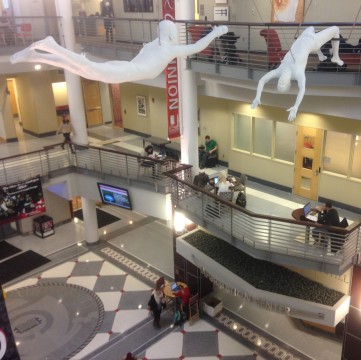
George Segal’s bronze sculptures, “Circus Acrobats,” soar over the Ohio Union’s atrium.
Credit: Franz Ross / Lantern TV station manager
Earlier this month, the Ohio Union got a high-flying addition.
Looking up toward the ceiling of the Great Hall, one might notice two white figures posing in the rafters. These figures are sculptures titled “Circus Acrobats,” created by pop art sculptor George Segal. The piece was a permanent donation to Ohio State by the George and Helen Segal Foundation and was installed Jan. 5.
“Circus Acrobats” follows the style of many of Segal’s most famous works, which are castings. He used bronze to cast the models in sections and then let them harden. After taking the hardened molds off, he would form them back together to create his sculptures. In this case, he finished by painting the figures white.
The donation from the foundation comes after photographer Donald Lokuta had an exhibit at OSU’s Urban Arts Space in 2013 which featured large print photographs of Segal working on his sculptures.
Richard Fletcher, an associate professor in the Department of Classics, made contact with Lokuta after seeing another one of his exhibitions to exchanged ideas about an exhibit at OSU.
He came to learn of the friendship that had been formed between Lokuta and Segal which led to the photographs in the Urban Arts Space exhibition. Their artistic history was deep, with Lokuta having posed for previous sculptures of Segal’s and having helped form the cast when Segal was the model.
As a result of that friendship, a Segal Foundation representative later emailed Fletcher expressing desire to donate a piece, specifically the “Circus Acrobats.” The gift came as a result of the university’s relationship with Lokuta, and his eventual relationship with Segal.
The university accepted the gift and after discussion on where to locate it, including the Oval-side foyer of Thompson Library, they decided on the Great Hall of the Ohio Union.
“Given the humanist nature of Segal’s work, the most important thing was for students to encounter the sculpture in their daily lives and activities on campus.” Fletcher said about the placement of the sculpture.
Jake Radeff, a second-year in environmental engineering, said he was confused by the sculptures at first, but has come to appreciate them.
“I walked through the Union the day they installed them and I didn’t really know what was going on,” he said. “But then I looked the sculptures and George Segal up.”
Radeff said he walks through the Union almost every day and typically looks up at the sculptures.
“I’m not usually into art but they’re something else.” Radeff said. “They’re cool. It’s impressive for OSU.”
Sean Prendergast, a third-year in electrical engineering, agreed that the sculptures are impressive but he has his reservations.
“I think putting it in the rafters wasn’t a great idea. It’s hard to see if you don’t look up.” he said.
But, Fletcher said, “rather than restrain the acrobats, it is better to see them fly — and having them up high would have that effect.”
As impressed as Fletcher is about the donation given Segal’s significance, for him, it is bigger than that.
“Its story involves so many OSU people, especially alumnus Donald Lokuta,” he said. “I think that the story behind it is equally uplifting and important for OSU students.”


